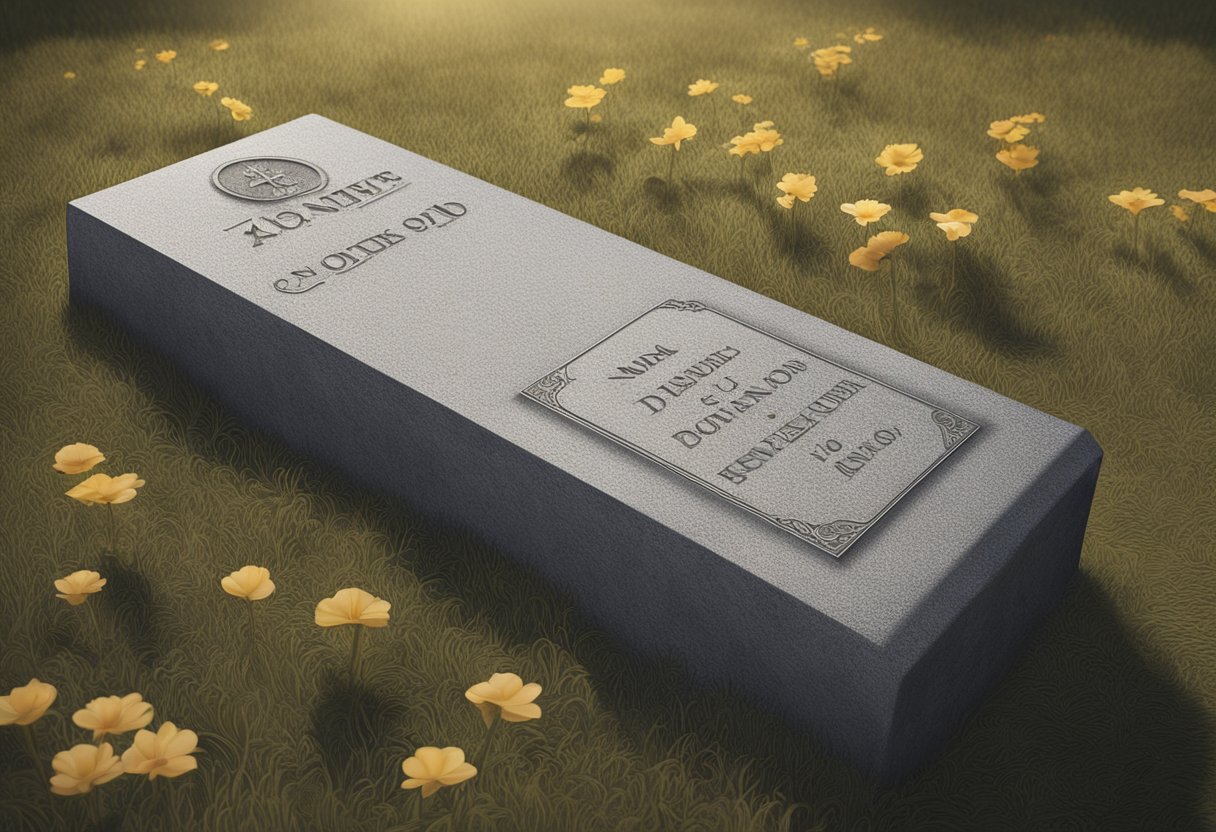Choosing a headstone is a unique opportunity to encapsulate the essence of a loved one with a lasting monument in their honor. The assortment of shapes for headstones provides a palette for personal expression within the tranquil setting of a cemetery. Square tops, serpentine, or the classic rounded arch, each shape carves a narrative in stone, as varied as the memories they symbolize. Modern cemeteries showcase these diverse designs, where personal preference and tradition guide the choice of a headstone’s silhouette.

Materials and craftsmanship play pivotal roles in transforming raw stone into a dignified tribute for the departed. Innovative techniques work in harmony with the timeless craft of masonry, delicately balancing between the robust language of durability and the softer whispers of intricate design. Epitaphs and inscriptions add yet another layer of customization, etching personal sentiments that echo through the ages. Practical elements like size, weather resistance, and maintenance requirements also steer decisions in this tangible discourse between the living and the memory of the deceased.
Key Takeaways
- Headstone shapes offer a way to personalize a final tribute in a variety of designs.
- The choice of material and quality of craftsmanship influence the headstone’s aesthetics and durability.
- Inscriptions add personal touches while practical aspects ensure the monument’s longevity.
The Great Headstone Shape Debate
https://www.youtube.com/watch?v=txAIS7wUEsU&embed=true
Choosing the perfect headstone shape can be as much of a personal statement as the epitaph itself. From classic to contemporary, the debate over which headstone shape reigns supreme is alive and well in cemeteries across the globe.
The Flat Pack
Flat headstones, often hailed for their simplicity and easy maintenance, maintain a firm ground in the shape debate. They mark the resting place with modesty, sometimes etched with a hint of detail just to keep one guessing.
- Pros: Lawn-friendly; unobtrusive
- Cons: Less visible from a distance
Bevel Believers
The slant of a bevel headstone ignites the imagination, with just enough rise to catch the eye without standing too tall. Fans argue that the angled inscription is easier to read for passersby perusing the plots.
- Pros: Improved readability; Mid-range prominence
- Cons: Limited space for customization
Slanting Sensations
A tad more expressive, slant headstones offer a sloped face, perfect for those who prefer a balance of modesty and flair. Their admirers appreciate the broad canvas for inscriptions that slant headstones provide.
- Pros: Balanced visibility; generous inscription space
- Cons: Can be prone to weather wear on the angle
Upright & Personal
Upright headstones stand tall, refusing to be overlooked. They come in various shapes, from the stalwart rectangle to the soothing circle, but all offer a dignified presence that says, “Here lies an individual worth noticing.”
- Pros: High visibility; ample space for design
- Cons: Can require more maintenance due to larger exposed surfaces
Full-Scale Creativity
At the pinnacle of expression lies the realm of custom shapes. Departing from the conventional, one might find an upright headstone embracing an oval elegance or another audaciously shaped like the deceased’s favorite guitar. Unique headstones break the mold, and for many, this is where the true art of memorialization flourishes.
- Pros: Complete personalization; no creative limits
- Cons: Often higher cost; may be restricted by cemetery regulations
In the end, whether one leans towards the understated flat or revels in the full-scale creativity of custom shapes, headstones are as individual as the people they honor. Each shape carries its own character, ready to spark a debate among the living about the best way to honor those who have moved on.
Materials & Craftsmanship Capers

Choosing headstone materials is akin to selecting the perfect attire for an eternal event: one must consider durability, style, and a dash of flair. Enter the world of stonework fashion, where granite guffaws at the elements, marble marvels with its veined beauty, and bronze behaves with a bold brilliance.
Granite Guffaws
Granite, she’s the reliable one in the material world – think of her as the denim jeans of headstones. Resistant to weather, graffiti, and sassy remarks from marble, granite has become the go-to for sturdiness and longevity.
- Pros: Durable, plentiful, laughs in the face of acid rain
- Variety: From ‘Strictly Gray’ to ‘Party Pink’
- Craftsmanship: Tailor-made for intricate engravings and art
Marvelous Marble
Ah, Marble – the life of the party in the stone soiree. She’s the one who can pull off a complex inscription with a twirl and a wink, capturing light and admiration with her crystalline charm. However, she’s a bit of a diva; rain and frost can be unkind to her polished surface.
- Character: Sophisticated, with natural patterns that bedazzle
- Use: Beloved for statues and inscriptions that demand grandeur
- Care: High maintenance, prefers temperate weather ‘scenes’
Bronzed and Bold
Bronze is the James Bond of headstone materials – never tarnishing under pressure and always looking dapper. He’s the chap that pairs well with a stone base, knows the value of a good engraving, and pays homage to the greats with skillful art.
- Composition: A seasoned mix of copper and tin
- Aesthetics: Offers a gleaming, enduring presence
- Function: They do more than stand there looking pretty; they offer inscriptions with a dignified patina over time
Inscriptions & Epitaphs Escapades
https://www.youtube.com/watch?v=jNWRanH41EE&embed=true
When it comes to headstones, names and dates of birth may lay the groundwork, but it’s the inscriptions and epitaphs that truly tell the tale. They etch stories in stone, tickle funny bones with puns, or simply encapsulate a life in a few choice words.
Font Fun
Headstone typography can be just as revealing as the words themselves. Serif fonts like Times New Roman, with their elegant embellishments, bring a classic gravitas to inscriptions. On the flip side, those who prefer a modern no-frills approach opt for sans-serif fonts such as Arial, which might suggest the individual enjoyed a more contemporary or minimalist lifestyle.
In the realm of the etched, some deceased jesters have had their final laugh with whimsical fonts such as Comic Sans, ensuring their gravestones stand out and perhaps draw a chuckle from passersby.
Quote Quirks
An epitaph is an individual’s last chance to amuse, inspire, or befuddle the living:
- Famous Last Words: Many choose epitaphs that were once uttered by historical figures or taken from literature, giving the stone a reflective or philosophical edge.
- Personal Catchphrases: Some gravestones include a deceased’s signature saying, potentially leaving visitors pondering phrases like “Always bet on the underdog.”
A table of stylized epitaph examples:
| Epitaph Style |
Humorous Example |
Solemn Example |
| Literary |
“Dead. Fin.” |
“Into the eternal night, I write.” |
| Pun-Laden |
“I told you I was sick!” |
N/A |
| Thoughtful |
“Gone fishing forever.” |
“Returned to the earth, only to bloom again.” |
Practical Considerations Wit
When picking out a headstone, one must juggle the somber rules of the cemetery with the heft of their wallet. Navigating these considerations can be as tricky as a circus act and as surprising as discovering a two-for-one deal on your favorite cereal.
https://www.youtube.com/watch?v=RqDrcGGhOEU&embed=true
Cemetery Circus
Each cemetery has its own ringmaster in the form of cemetery rules. These rules dictate the shape, size, and material of headstones that one can plant on their dearly departed’s final patch of green. Behold the guidelines:
- Size Restrictions: Big tops are out. Some cemeteries may limit the headstone’s height or width.
- Material Requirements: Not all materials are welcome under the big tent. One’s options can be limited to what will endure the test of time, such as granite or marble.
- Design Regulations: Flamboyant designs may need to be tamed. It’s about finding elegance in simplicity.
Monetary Mirths
When it comes to cost, the pursuit of an affordable headstone need not be a solemn affair. Budgeting for a headstone can invoke the merriness of squeezing value from every penny. Behold, the tips to avoid getting ‘stoned’ financially:
- Compare Materials: Granite steals the show for durability and cost, while marble takes a bow for its classic beauty.
- Shop Around: They may not have coupons or early bird specials, but many a monument maker might offer a handshake deal or seasonal discounts.
- Prioritize: Decide what’s essential – a dash of engraving or an extra inch? Every choice tickles the price.
By keeping these considerations in mind, the headstone hunt becomes less of a tightrope walk over a sea of concerns and more of a delightful dance through a carnival of choices.







